
Is your mattress sagging? Does it feel lumpy and uneven? Is there a deep trench running right down the middle? If your answer is yes to any of these questions, it’s probably time to get a new mattress. All mattresses go through wear and tear over time and lose their firmness and structure. In the long run, this can cause you aches and pains. So knowing when to replace your mattress will keep the backaches at bay. Keep reading to find out about when and how to replace your mattresses.
So How Long Can a Mattress Last?
Usually, mattresses can last for a good seven years before you’d need to start looking for a replacement. Of course, some beds are made from materials that are more sensitive to wear and tear, making them less firm and more uncomfortable before the seven-year mark. Better quality and more durable materials will last seven or more years.
|
Oliver Smith® Organic Cotton 10" Firm Comfort Sleep Spring & Foam Hybrid Mattress Oliver Smith® Organic, 12 Inch Euro Pillow Top, Cool Memory Foam & Pocket Spring Mattress Oliver Smith® Organic Cotton 12" Firm Mattress With Cool Memory Foam & Pocket Spring |
Average Lifespan of hybrid mattresses:
6-7 years |
|
HomeLife® Comfort Sleep 6" Mattress Home Life® Organic Cotton, Euro Top Pillow 8" Inches, Pocket Spring Mattress |
Average Lifespan of spring mattresses: 5-7 years |
Why do mattresses wear out?
There are a couple of reasons that can cause mattresses to wear out.
- Normal Wear and Tear: This is something all mattresses will go through. As your mattress materials wear out with time, they will lose their firmness and you'll start to notice a bit of sagging.
- Not Enough Support: Your mattress can face further wear and tear if the frame, foundation or base that you use for your mattress does not provide proper support. If your slats are too widely spaced, the mattress can sag through the gaps too.
-
Extreme Temperatures: (extreme high or low temperatures)
Some mattresses - especially all-foam beds- can wear out faster if you constantly maintain an extreme cold or hot temperature in the room. -
Jumping on the Surface: Naturally, your bed will wear out faster if you, your pets or children jump on the mattress often.
- Signs that it’s time to replace your mattress
- You start to get new pains in your back, neck and shoulders.
- You notice the mattress starts to sink around the edges first.
- There are deep body impressions left on the surface of the mattress. Check if the impressions can be covered under warranty.
- It feels warmer than usual. When you sink more deeply into the bed, the airflow is restricted, making you feel a lot warmer than usual.
- Your spring or hybrid mattress starts to make a lot of noise.
- Your bed is more than seven-years-old.
Understanding Mattress Warranties
After you buy a mattress, register the warranty. Today, you can do it conveniently online. If you forget to register your warranty within the specified time, you may not get the warranty. Warranties can save you a lot of money, When your mattress develops a defect, your mattress manufacturer will replace or replace it before the warranty expires.
Defects
Your mattress manufacturer will provide a list of defects that are covered in the warranty. There are the defects that are most commonly covered by warranties:
- Manufacturing defects
- Body impressions on the mattress surface that has reached a certain depth.
-
Defective springs that are protruding through the mattress.
Make your mattress last longer by rotating it often. You should also use a mattress topper from the get-go so that you protect your mattress surface from future dents. Don’t forget to check your mattress frame and base from time to time, because it can also go through wear and tear. Most importantly, keep your bedroom clean so that you will not get a nasty visit from dust mites, moulds or other kinds of contaminants.

